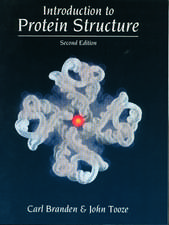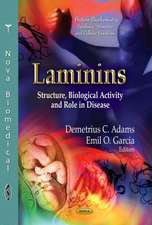The Nuclear Receptor Superfamily: Methods and Protocols: Methods in Molecular Biology, cartea 505
Editat de Iain J. McEwanen Limba Engleză Hardback – 12 dec 2008
Cutting-edge and easy to use, The Nuclear Receptor Superfamily: Methods and Protocols provides beneficial and time-saving guidance for all those undertaking research in this ever-growing field of study.
| Toate formatele și edițiile | Preț | Express |
|---|---|---|
| Paperback (1) | 642.84 lei 38-44 zile | |
| Humana Press Inc. – 19 noi 2010 | 642.84 lei 38-44 zile | |
| Hardback (1) | 574.96 lei 38-44 zile | |
| Humana Press Inc. – 12 dec 2008 | 574.96 lei 38-44 zile |
Din seria Methods in Molecular Biology
- 9%
 Preț: 791.63 lei
Preț: 791.63 lei - 23%
 Preț: 598.58 lei
Preț: 598.58 lei - 20%
 Preț: 882.98 lei
Preț: 882.98 lei -
 Preț: 252.05 lei
Preț: 252.05 lei - 5%
 Preț: 802.70 lei
Preț: 802.70 lei - 5%
 Preț: 729.61 lei
Preț: 729.61 lei - 5%
 Preț: 731.43 lei
Preț: 731.43 lei - 5%
 Preț: 741.30 lei
Preț: 741.30 lei - 5%
 Preț: 747.16 lei
Preț: 747.16 lei - 15%
 Preț: 663.45 lei
Preț: 663.45 lei - 18%
 Preț: 1025.34 lei
Preț: 1025.34 lei - 5%
 Preț: 734.57 lei
Preț: 734.57 lei - 18%
 Preț: 914.20 lei
Preț: 914.20 lei - 15%
 Preț: 664.61 lei
Preț: 664.61 lei - 15%
 Preț: 654.12 lei
Preț: 654.12 lei - 18%
 Preț: 1414.74 lei
Preț: 1414.74 lei - 5%
 Preț: 742.60 lei
Preț: 742.60 lei - 20%
 Preț: 821.65 lei
Preț: 821.65 lei - 18%
 Preț: 972.30 lei
Preț: 972.30 lei - 15%
 Preț: 660.49 lei
Preț: 660.49 lei - 5%
 Preț: 738.41 lei
Preț: 738.41 lei - 18%
 Preț: 984.92 lei
Preț: 984.92 lei - 5%
 Preț: 733.29 lei
Preț: 733.29 lei -
 Preț: 392.60 lei
Preț: 392.60 lei - 5%
 Preț: 746.26 lei
Preț: 746.26 lei - 18%
 Preț: 962.66 lei
Preț: 962.66 lei - 23%
 Preț: 860.22 lei
Preț: 860.22 lei - 15%
 Preț: 652.64 lei
Preț: 652.64 lei - 5%
 Preț: 1055.50 lei
Preț: 1055.50 lei - 23%
 Preț: 883.87 lei
Preț: 883.87 lei - 19%
 Preț: 491.89 lei
Preț: 491.89 lei - 5%
 Preț: 1038.86 lei
Preț: 1038.86 lei - 5%
 Preț: 524.16 lei
Preț: 524.16 lei - 18%
 Preț: 2122.34 lei
Preț: 2122.34 lei - 5%
 Preț: 1299.23 lei
Preț: 1299.23 lei - 5%
 Preț: 1339.12 lei
Preț: 1339.12 lei - 18%
 Preț: 1390.26 lei
Preț: 1390.26 lei - 18%
 Preț: 1395.63 lei
Preț: 1395.63 lei - 18%
 Preț: 1129.65 lei
Preț: 1129.65 lei - 18%
 Preț: 1408.26 lei
Preț: 1408.26 lei - 18%
 Preț: 1124.92 lei
Preț: 1124.92 lei - 18%
 Preț: 966.27 lei
Preț: 966.27 lei - 5%
 Preț: 1299.99 lei
Preț: 1299.99 lei - 5%
 Preț: 1108.51 lei
Preț: 1108.51 lei - 5%
 Preț: 983.76 lei
Preț: 983.76 lei - 5%
 Preț: 728.16 lei
Preț: 728.16 lei - 18%
 Preț: 1118.62 lei
Preț: 1118.62 lei - 18%
 Preț: 955.25 lei
Preț: 955.25 lei - 5%
 Preț: 1035.62 lei
Preț: 1035.62 lei - 18%
 Preț: 1400.35 lei
Preț: 1400.35 lei
Preț: 574.96 lei
Preț vechi: 709.83 lei
-19% Nou
Puncte Express: 862
Preț estimativ în valută:
110.05€ • 119.58$ • 92.50£
110.05€ • 119.58$ • 92.50£
Carte tipărită la comandă
Livrare economică 18-24 aprilie
Preluare comenzi: 021 569.72.76
Specificații
ISBN-13: 9781603275743
ISBN-10: 1603275746
Pagini: 240
Ilustrații: 240 p. 43 illus., 4 illus. in color.
Dimensiuni: 193 x 260 x 20 mm
Greutate: 0.76 kg
Ediția:2009
Editura: Humana Press Inc.
Colecția Humana
Seria Methods in Molecular Biology
Locul publicării:Totowa, NJ, United States
ISBN-10: 1603275746
Pagini: 240
Ilustrații: 240 p. 43 illus., 4 illus. in color.
Dimensiuni: 193 x 260 x 20 mm
Greutate: 0.76 kg
Ediția:2009
Editura: Humana Press Inc.
Colecția Humana
Seria Methods in Molecular Biology
Locul publicării:Totowa, NJ, United States
Public țintă
Professional/practitionerCuprins
Nuclear Receptors: One Big Family.- Ligand Binding and Nuclear Receptor Turnover.- Methods for Measuring Ligand Dissociation and Nuclear Receptor Turnover in Whole Cells.- Flow Cytometry as a Tool for Measurement of Steroid Hormone Receptor Protein Expression in Leukocytes.- X-Ray Crystallography of Agonist/Antagonist-Bound Receptors.- Nuclear Localization and DNA Binding.- FRAP and FRET Methods to Study Nuclear Receptors in Living Cells.- Receptor-DNA Interactions: EMSA and Footprinting.- Chromatin Immunoprecipitation (ChIP) Methodology and Readouts.- Nuclear Receptor—Co-Regulatory Protein Interactions.- Yeast-Based Reporter Assays for the Functional Characterization of Cochaperone Interactions with Steroid Hormone Receptors.- High Throughput Analysis of Nuclear Receptor–Cofactor Interactions.- Binding Affinity and Kinetic Analysis of Nuclear Receptor/Co-Regulator Interactions Using Surface Plasmon Resonance.- Using RNA Interference to Study Protein Function.- Using Intrinsic Fluorescence Emission Spectroscopy to Study Steroid Receptor and Coactivator Protein Conformation Dynamics.- Pathophysiological Analysis of Nuclear Receptor Function.- Development of Phosphorylation Site-Specific Antibodies to Nuclear Receptors.- Tissue-Selective Knockouts of Steroid Receptors: A Novel Paradigm in the Study of Steroid Action.- Methods for Identifying and Studying Genetic Alterations in Hormone-Dependent Cancers.
Recenzii
From the reviews:
"The primary focus is on cellular biology, biochemistry and molecular biology. … It is written for a wide range of basic science and clinical researchers interested in transcriptional control of gene expression … . Biomedical scientists and clinicians … will appreciate the wealth of new information presented by the authors, all experts in the field. … This is an outstanding contribution to the literature. … This carefully edited collection of protocols will be valued by all those interested in steroid hormones and nuclear receptors." (Bruce A. Fenderson, Doody’s Review Service, May, 2009)
“This book form part of the series Methods in Molecular Biology and describes methods commonly used to investigate the structural and functional relationship of nuclear receptors, as well as the physiopathology and potential pharmacologic agents for use in therapy of these disorders. … On consulting this book, researchers, students and professionals in the areas of biology and public health will have an opportunity to update their knowledge of experimental methods and applications of functional studies of nuclear receptors and their therapeutic implications.” (Rosario D. C. Hirata, Brazilian Journal of Pharmaceutical Science, Spring, 2010)
"The primary focus is on cellular biology, biochemistry and molecular biology. … It is written for a wide range of basic science and clinical researchers interested in transcriptional control of gene expression … . Biomedical scientists and clinicians … will appreciate the wealth of new information presented by the authors, all experts in the field. … This is an outstanding contribution to the literature. … This carefully edited collection of protocols will be valued by all those interested in steroid hormones and nuclear receptors." (Bruce A. Fenderson, Doody’s Review Service, May, 2009)
“This book form part of the series Methods in Molecular Biology and describes methods commonly used to investigate the structural and functional relationship of nuclear receptors, as well as the physiopathology and potential pharmacologic agents for use in therapy of these disorders. … On consulting this book, researchers, students and professionals in the areas of biology and public health will have an opportunity to update their knowledge of experimental methods and applications of functional studies of nuclear receptors and their therapeutic implications.” (Rosario D. C. Hirata, Brazilian Journal of Pharmaceutical Science, Spring, 2010)
Textul de pe ultima copertă
Acting principally to control patterns of gene expression, nuclear receptors play vital roles during embryonic development and in the regulation of metabolic and reproductive functions in adult life, which proves this superfamily of ligand-activated transcription factors to be a crucial part of biological life. In The Nuclear Receptor Superfamily: Methods and Protocols, expert researchers describe a range of molecular, structural and cell biological techniques currently used to investigate the structure-function of nuclear receptors, together with experimental approaches that may lead to new therapeutic strategies for treating nuclear receptor-associated diseases. Written in the highly successful Methods in Molecular Biology™ series format, the chapters in this volume contain brief introductions to the topics, lists of the necessary materials and reagents, step-by-step, readily reproducible laboratory protocols, as well as notes from the experts to highlight tips on troubleshooting and avoiding known pitfalls.
Cutting-edge and easy to use, The Nuclear Receptor Superfamily: Methods and Protocols provides beneficial and time-saving guidance for all those undertaking research in this ever-growing field of study.
Cutting-edge and easy to use, The Nuclear Receptor Superfamily: Methods and Protocols provides beneficial and time-saving guidance for all those undertaking research in this ever-growing field of study.
Caracteristici
Provides an easily accessible reference for a range of biochemical and cell-based methods to study nuclear receptor function Clear step-by-step comprehensive guides written by experienced researchers in the field Covers cutting-edge methodologies, including ChIP-on-chip, siRNA gene silencing and tissues selective gene knock-outs Details analysis from isolated receptor proteins through to cellular and tissue function Presents experimental approaches, including the use of model biological systems and high-throughput screening, that can be applied to translational research













